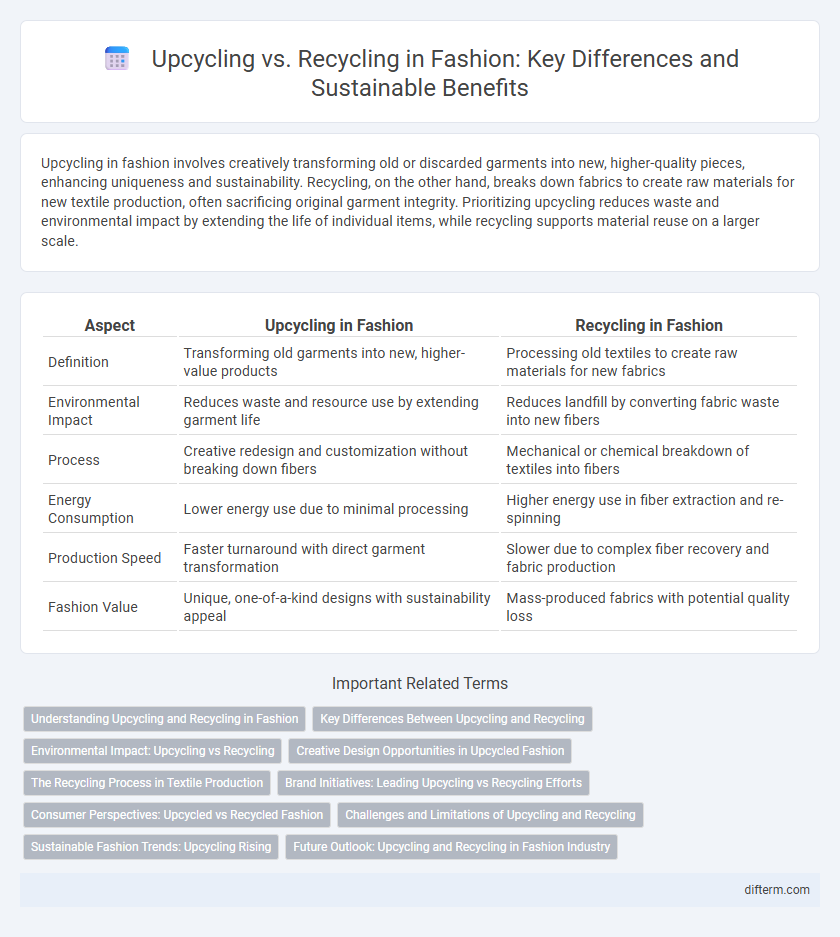Upcycling in fashion involves creatively transforming old or discarded garments into new, higher-quality pieces, enhancing uniqueness and sustainability. Recycling, on the other hand, breaks down fabrics to create raw materials for new textile production, often sacrificing original garment integrity. Prioritizing upcycling reduces waste and environmental impact by extending the life of individual items, while recycling supports material reuse on a larger scale.
Table of Comparison
| Aspect | Upcycling in Fashion | Recycling in Fashion |
|---|---|---|
| Definition | Transforming old garments into new, higher-value products | Processing old textiles to create raw materials for new fabrics |
| Environmental Impact | Reduces waste and resource use by extending garment life | Reduces landfill by converting fabric waste into new fibers |
| Process | Creative redesign and customization without breaking down fibers | Mechanical or chemical breakdown of textiles into fibers |
| Energy Consumption | Lower energy use due to minimal processing | Higher energy use in fiber extraction and re-spinning |
| Production Speed | Faster turnaround with direct garment transformation | Slower due to complex fiber recovery and fabric production |
| Fashion Value | Unique, one-of-a-kind designs with sustainability appeal | Mass-produced fabrics with potential quality loss |
Understanding Upcycling and Recycling in Fashion
Upcycling in fashion transforms old or discarded garments into new, higher-value products, preserving materials and reducing waste without breaking them down chemically. Recycling involves processing textiles into fibers to create new fabrics, often requiring significant energy and potentially reducing material quality. Both methods aim to minimize environmental impact, but upcycling retains original fabric integrity while recycling supports large-scale material reuse.
Key Differences Between Upcycling and Recycling
Upcycling in fashion involves creatively transforming discarded garments into new, higher-value products, preserving original materials and often enhancing design appeal. Recycling, on the other hand, breaks down textiles to produce raw fibers or fabrics that can be reprocessed into entirely new items, often resulting in lower material quality. Upcycling emphasizes craftsmanship and uniqueness, while recycling prioritizes material recovery and large-scale sustainability.
Environmental Impact: Upcycling vs Recycling
Upcycling in fashion minimizes textile waste by transforming old garments into higher-value products, reducing the demand for virgin materials and lowering carbon emissions. Recycling involves breaking down fibers to create new fabrics, which can still consume energy and chemicals, though less than producing new textiles from raw resources. Upcycling generally offers a more sustainable environmental impact than recycling by extending product lifespan and avoiding additional processing.
Creative Design Opportunities in Upcycled Fashion
Upcycled fashion offers unique creative design opportunities by transforming discarded materials into innovative, one-of-a-kind garments that reflect artistic craftsmanship and sustainability. Unlike recycling, which breaks down fibers for reuse in new fabric, upcycling retains original textures and structures, allowing designers to experiment with patchwork, embellishments, and customization. This approach not only reduces textile waste but also elevates fashion with distinctive stories and personalized aesthetics.
The Recycling Process in Textile Production
The recycling process in textile production involves breaking down used fabrics into fibers, which are then re-spun into new yarns to create fresh garments, significantly reducing landfill waste. Mechanical recycling shreds textiles, preserving fiber quality for reuse, while chemical recycling breaks down fibers at a molecular level for higher-quality outputs. This process supports sustainable fashion by minimizing resource consumption and lowering carbon emissions compared to virgin textile production.
Brand Initiatives: Leading Upcycling vs Recycling Efforts
Fashion brands like Patagonia and Eileen Fisher spearhead upcycling initiatives by transforming vintage fabrics into limited-edition collections, emphasizing creativity and waste reduction. In contrast, companies such as H&M and Levi's prioritize recycling by incorporating post-consumer textile waste into new fibers, promoting circularity at scale. These brand efforts highlight a growing commitment to sustainability by balancing innovative upcycling craftsmanship with efficient recycling technologies.
Consumer Perspectives: Upcycled vs Recycled Fashion
Consumers increasingly favor upcycled fashion for its uniqueness and reduced environmental impact, viewing it as a creative way to extend garment life. Recycled fashion appeals to eco-conscious buyers seeking products made from regenerated materials like recycled fibers or fabrics, emphasizing sustainability through resource conservation. Preference often depends on values around originality versus circular economy principles in fashion consumption.
Challenges and Limitations of Upcycling and Recycling
Upcycling in fashion faces challenges such as the limited scalability and inconsistent quality of materials, making mass production difficult and costly. Recycling struggles with fiber degradation and the complexity of separating mixed fabrics, which reduces the efficiency and quality of recycled textiles. Both processes encounter limitations in meeting fast fashion demands while maintaining sustainability standards.
Sustainable Fashion Trends: Upcycling Rising
Upcycling in sustainable fashion transforms discarded garments into unique, high-quality pieces, reducing textile waste and minimizing environmental impact more effectively than traditional recycling. This trend embraces creativity by enhancing the original fabric's value without breaking it down, preserving resources and energy typically consumed in recycling processes. Major fashion brands increasingly adopt upcycling to meet consumer demand for eco-friendly, one-of-a-kind apparel, driving a shift toward circular economy practices within the industry.
Future Outlook: Upcycling and Recycling in Fashion Industry
Upcycling in the fashion industry is projected to grow as consumers increasingly demand unique, sustainable products that reduce waste and carbon footprints. Recycling technologies are advancing, enabling more efficient processing of textiles, which supports circular fashion models and minimizes landfill impact. Both upcycling and recycling are integral to achieving sustainability goals, driving innovation in material use and promoting eco-conscious consumer behavior in future fashion trends.
Upcycling vs recycling (in fashion) Infographic

 difterm.com
difterm.com